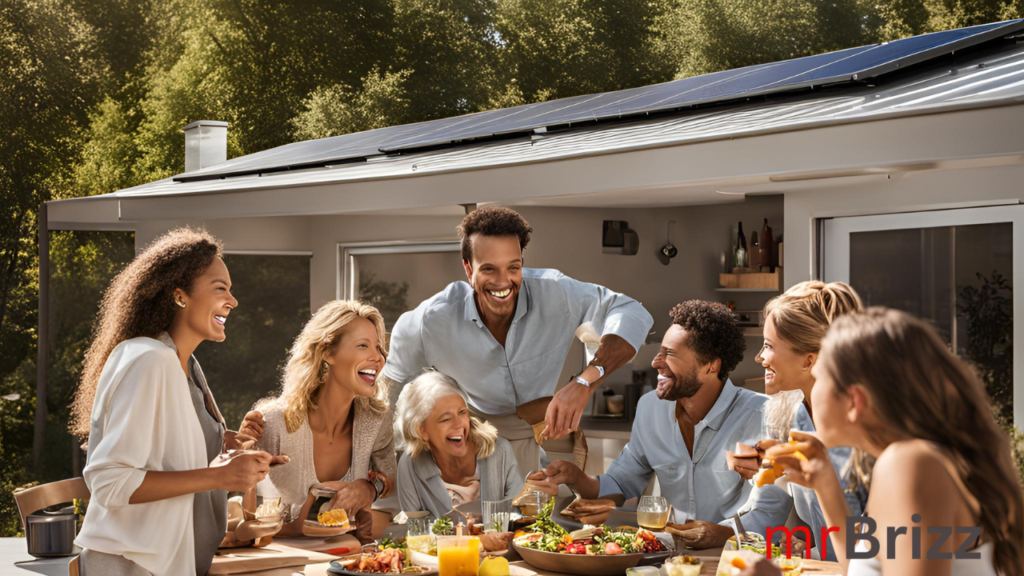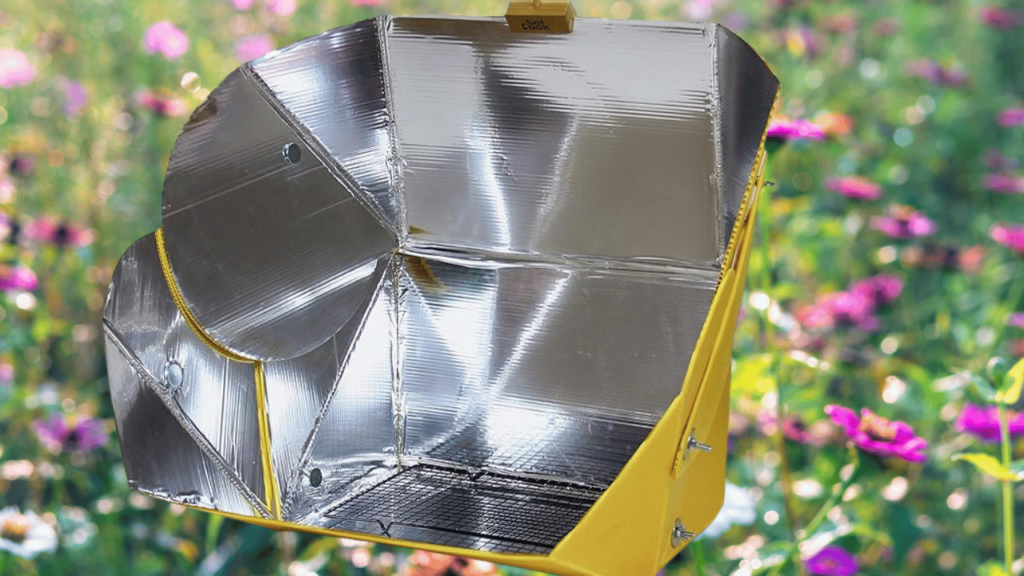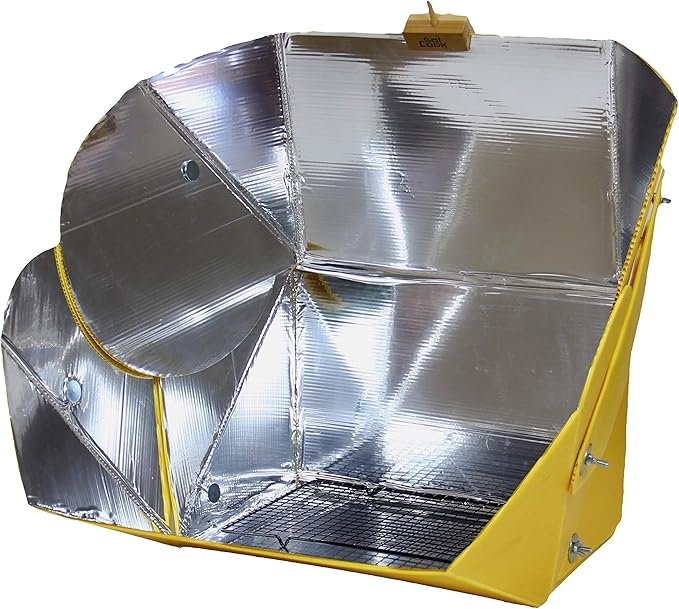
The sun is shining, the birds are singing, and your taste buds are tingling with excitement. If you’re an outdoor enthusiast, or camper, then solar ovens for outdoor cooking are about to change your life in the best way possible.
In this in-depth guide, we’ll take you on a journey through the wonderful world of solar ovens, exploring their benefits, the top models on the market, must-know cooking tips, and so much more. By the end, you’ll be ready to ditch the campfire and embrace the future of sustainable, sun-powered outdoor cooking.
What Are Solar Ovens and How Do They Work?
Solar ovens, also known as “solar cookers,” are devices that use the sun’s energy to heat up and cook food. They come in a variety of shapes and sizes, but the basic principle is the same: a reflective surface, often made of metal or mirrored material, concentrates the sun’s rays onto a cooking chamber, where the temperature can reach up to 400°F (204°C) or more.
The most common types of solar ovens include:

- Box Ovens: These resemble traditional box-shaped ovens, with a reflective interior and a transparent lid or door to allow sunlight in. Box ovens are a popular choice for their simplicity and versatility, making them a great option for both casual campers and off-grid enthusiasts. CLICK TO VIEW

- Parabolic Cookers: Featuring a curved, dish-like reflector, parabolic cookers focus the sun’s rays onto a small cooking area, allowing for intense heat. These types of solar ovens are ideal for quick-cooking meals and can reach temperatures rivaling conventional gas or electric ovens.

- Panel Cookers: Made up of a series of reflective panels that can be adjusted to track the sun, panel cookers are lightweight and portable, making them a fantastic choice for backpacking, camping, and other outdoor adventures where weight and space are at a premium.
No matter which design you choose, the key to getting the most out of your solar oven is positioning it to capture as much direct sunlight as possible throughout the day. By continuously adjusting the oven’s orientation, you can ensure your meals are cooked to perfection using the power of the sun.

Benefits of Using Solar Ovens for Outdoor Cooking
The advantages of incorporating solar ovens into your outdoor cooking routine are numerous and compelling. Let’s dive into some of the top reasons why you should consider making the switch from traditional cooking methods:
Eco-Friendly and Sustainable: Solar ovens are a completely renewable, emissions-free way to cook, making them a game-changer for the environmentally conscious outdoor enthusiast.
Energy Savings and Cost-Effective: Once you’ve invested in a solar oven, your fuel costs for cooking will be virtually nonexistent. This can lead to significant long-term savings, especially for those who enjoy frequent outdoor adventures or live off-grid, where access to traditional cooking fuels may be limited or costly.
Versatility and Cooking Capabilities: Don’t be fooled by their simple design – solar ovens are capable of cooking a wide variety of foods, from hearty stews and roasts to delicate baked goods. Many models can even reach temperatures rivaling traditional kitchen ovens, allowing you to create a diverse array of dishes without the need for electricity or gas.
Off-Grid and Emergency Preparedness: For those who love to venture into the great outdoors or are interested in off-grid living, solar ovens are a game-changer. They provide a reliable, fuel-free way to cook, making them essential for emergency preparedness kits or survival situations where access to traditional cooking sources may be limited.
Safety and Convenience: Unlike campfires or gas-powered stoves, solar ovens eliminate the risk of open flames or toxic fumes, making them a safer option for outdoor cooking. And with no need to constantly tend to the heat source, you can sit back, relax, and let the sun do the work.
Versatility for Outdoor Events and Festivals: Solar ovens are not just for individual campers and backpackers – they can also be a valuable asset for larger outdoor gatherings, such as festivals, community events, or even catering operations. Their ability to cook food efficiently and sustainably makes them an increasingly popular choice for eco-conscious event organizers.
Integration with Other Renewable Energy Sources: As the world continues to embrace renewable energy solutions, some innovative solar oven designs are being integrated with other green technologies, such as solar panels or wind turbines, creating a truly off-grid cooking system that can power not just the oven but also other essential outdoor equipment.
Top Solar Oven Models for Outdoor Cooking in 2024
With so many solar oven options on the market, it can be overwhelming to choose the right one for your needs. Here are some of the top models to consider in 2024:

1. GoSun Sport Solar Oven: A popular choice for campers and backpackers, the GoSun Sport is a lightweight, portable panel cooker that can reach temperatures up to 550°F (288°C), making it a versatile option for quick-cooking meals and even baking.

2. All Season Solar Cooker: This versatile box oven features a collapsible, adjustable design and can accommodate a variety of cookware, making it perfect for family outdoor adventures, group camping trips, or even small-scale outdoor events and festivals.
No matter which model you choose, be sure to consider factors like portability, cooking capacity, maximum temperature, and ease of use to find the perfect solar oven for your outdoor adventures, off-grid living, or even sustainable catering and event needs.
Cooking with Solar Ovens: Tips and Tricks
Mastering the art of solar oven cooking takes a bit of practice, but with these helpful tips and tricks, you’ll be whipping up delicious, sun-powered meals in no time:
Adjust Positioning for Maximum Efficiency: Continuously reposition your solar oven to ensure it’s capturing the most direct sunlight throughout the day, as this will significantly impact your cooking times and temperatures. Many solar oven models come with adjustable stands or reflectors to make this process easier.
Experiment with Different Foods: Solar ovens are surprisingly versatile, so don’t be afraid to try your hand at a wide variety of recipes, from hearty casseroles and stews to flaky baked goods. The key is to understand the specific cooking times and techniques required for each type of dish.
Plan for Varying Conditions: Be prepared to adjust your cooking times and techniques based on cloud cover, wind, and other environmental factors that can affect the performance of your solar oven. Keeping a close eye on the internal temperature and making adjustments as needed will help you achieve consistent results, even in less-than-ideal weather conditions.
Invest in Oven-Safe Cookware: Choose pots, pans, and bakeware that are specifically designed for use in solar ovens, as they’re often shaped and sized to optimize heat absorption and distribution.
Practice Food Safety: Always use proper food handling and storage techniques when cooking with a solar oven, just as you would with any other outdoor cooking method. This includes monitoring internal temperatures to ensure food is cooked thoroughly and safely.
Experiment with Cooking Techniques: Solar oven cooking allows for a wide range of techniques, from roasting and baking to steaming and even dehydrating. Don’t be afraid to get creative and try new methods to find the ones that work best for your specific recipes and solar oven model.
By following these tips and incorporating a bit of trial and error, you’ll soon be a solar oven cooking pro, whipping up delectable meals that are as good for the planet as they are for your taste buds.
FAQs About Solar Ovens for Outdoor Cooking
Q: How hot do solar ovens get, and how long does it take to cook food?
A: Solar ovens can reach temperatures of up to 400°F (204°C) or more, rivaling traditional kitchen ovens. Cooking times can vary depending on the specific model, weather conditions, and the type of food being prepared, but many dishes can be cooked in as little as 1-2 hours. Some high-performance parabolic solar cookers can even achieve temperatures up to 550°F (288°C), allowing for even quicker cooking times.
Q: Can you bake in a solar oven, or is it only good for savory dishes?
A: Absolutely! Solar ovens are incredibly versatile and can be used to bake a wide variety of foods, from bread and pastries to cakes and pies. The key is to experiment with different recipes and adjust cooking times and temperatures accordingly. Many solar oven owners report great success in baking everything from flaky biscuits to moist, fluffy cakes using their sun-powered ovens.
Q: Do solar ovens work well in cloudy or overcast conditions?
A: Solar ovens do rely on direct sunlight to function effectively, so their performance can be impacted by cloud cover or other environmental factors. However, many models are designed to still capture and concentrate available light, even on partially cloudy days. Adjusting the oven’s positioning and being prepared to extend cooking times can help mitigate the effects of less-than-ideal weather. Some advanced solar ovens even incorporate thermal mass or backup heating elements to maintain consistent temperatures when direct sunlight is limited.
Q: Are solar ovens difficult to use and maintain?
A: Not at all! Solar ovens are generally quite simple to operate, with most models featuring intuitive designs and straightforward instructions. Maintenance is also minimal, typically just requiring occasional cleaning and proper storage when not in use. As long as you follow the manufacturer’s guidelines, using a solar oven can be a hassle-free and rewarding experience, even for those new to outdoor cooking.
Q: How much do solar ovens typically cost, and are they worth the investment?
A: The cost of solar ovens can vary widely, with models ranging from around $100 for basic, entry-level options to $300 or more for premium, high-performance units. However, the long-term fuel savings and environmental benefits often make solar ovens a wise investment, especially for frequent outdoor enthusiasts, off-grid adventurers, or those looking to reduce their carbon footprint. Many users report recouping the initial cost within a few years through the elimination of fuel expenses.
Q: Can solar ovens be integrated with other renewable energy sources?
A: Absolutely! As the demand for sustainable, off-grid cooking solutions grows, some innovative solar oven designs are being integrated with complementary renewable energy technologies, such as solar panels or wind turbines. This allows users to power not just the oven but also other essential outdoor equipment, creating a truly self-sufficient, eco-friendly cooking system. These integrated systems can be particularly useful for remote cabins, tiny homes, RVs, and other off-grid living situations.
Hopefully, these FAQs have helped to answer some of your burning questions about solar ovens and their use for outdoor cooking. If you have any other inquiries, feel free to reach out – we’re always happy to help you harness the power of the sun and elevate your outdoor culinary adventures.

Embracing the Future of Sustainable Outdoor Cooking
As we look towards the future, it’s clear that solar ovens are poised to play an increasingly important role in the world of outdoor cooking. With their unbeatable combination of eco-friendliness, cost-effectiveness, and impressive cooking capabilities, these ingenious devices offer a glimpse into a sustainable, sun-powered tomorrow.
Whether you’re an avid camper, a backyard grilling enthusiast, solar ovens provide a versatile and rewarding solution for all your outdoor cooking needs. From powering up delicious meals during off-grid adventures to hosting eco-conscious outdoor events and festivals, these solar-powered wonders are quickly becoming a must-have for the modern outdoor enthusiast.



